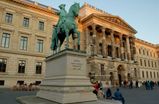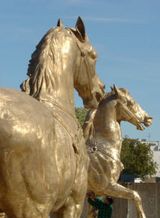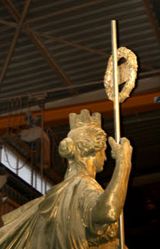The Path to the New Quadriga
When the new building of the Braunschweig Palace began to take shape in 2003 and the success of the project came within reach, it was decided to reconstruct the crown of the palace as well - the Quadriga.
The initial step in the reconstruction was to recast the original model made by Rietschel which had been discovered in the Scultpture Collection Albertina in Dresden in 1999. The cast made between autumn 2003 and May 2004 was financed by the Richard Borek Foundation, Braunschweig. Until the end of 2005, for the conversion of the models into full size gigantic figures measuring up to 9m in height which had already been dreaded by Rietschel, the following three options became apparent: electronic form routing, copper plate driving as used in the original and sculpting of full sized models and subsequent bronze casting. The Quadriga-Team finally decided on the latter classic method.
Manufacturing of the Full Size Models
The search for a suitable company with the required expertise in high quality bronze casting methods, large factory workshops and able sculptors lead to Poland. In Komorniki, a small village west of Poznan, the DBA Kosicki foundry met all required criteria and was commissioned, initially for a trial period, to produce the sculpture of a horse made by the sculptors employed there. It was specified, like later on for the chariot and Brunonia figure, that the models of Rietschel and their temperament should be copied exactly into the full size model. The trial horse was made by modellers Artur Wochniak and Arletta Kindermann according to the classical method using a plaster model on a polystyrene core with wire and iron reinforcements. In May 2006 the horse measuring 4.5 m in height was judged as good, so that the work could be commissioned in full.
Bronze Casting of the Quadriga
The size of the Quadriga figures only allowed single plates to be cast. The lost-wax casting is an ancient practice. This process was also used in the making of the Braunschweig Lion. For instance wax copies of the horse´s mane 50 x 70 cm in size are made from the full sized plaster model. In case of the horse´s legs which are used more than once a silicon mould is made first of all, which in turn is used to make several wax copies. The wax copy is then packed in clay and placed in a kiln where the wax melts and runs out. The clay shell has now hardened and become fire-proof. The hollow of the clay shell is a negative copy. Molten bronze is poured into the hollow in the subsequent cast.
The clay shell is hammered away releasing the bronze copy which is then polished to give it its form and initial golden shine. After a few weeks the colour will turn from gold to brown and after 20 years it will appear greenish. Finally the individual plates are welded together in time-consuming manual labour to form the horse figure.
Making of the Horses
After completing the plaster model of the first of the four horses, the three remaining models of impressive dimensions measuring 4.5 m in height, 4.7 m in length and 1.2 m body depth were manufactured. It took from June 2006 to April 2007 to accomplish this task. While in October 2006 parts of one horse were still being modelled in plaster, the casting of the first horse statue had already begun. In late autumn 2006, the first cast parts were already welded together. The casters could cast several identical components more than once which reduced their workload. Rietschel had only created to gaits which are repeated alternately a-b-a-b from the horse on the left to the horse on the right, in order to copy the rising trot of the horses. Only the bridle and lion heads adorning the horses´ breasts were identical, in any other aspect each horse was unique.
The First Presentation of the Quadriga Horses in Braunschweig
On 6 May 2007, the newly rebuilt Palace was handed over to the city of Braunschweig. For the first time the citizens were able to view the municipal rooms comprising 13000 m² on the ground floor in their palace-like form and again experience the palace in its original size. On this memorable day those parts of the Quadriga which had already been finished were also presented to the public- namely the four horses and the almost completed Brunonia. Despite their best efforts the foundry had not been able to finish the Quadriga. But a certain amount of comfort could be taken form the mounting of the huge horses onto their pedestal on top of the palace, 26m above the ground, providing a unique sight in itself. The not quite finished Brunonia remained on the castle courtyard, where she could be admired close up and in detail, in particular the head which had been cast from the Brunonia head from 1863 which is kept at the municipal museum.
The Quadriga Continues to Grow
In mid April 2007, the model for the large chariot measuring 4.6 m in length, 2.3 m in height and 2.6 m in width was completed. It was sectioned into vertical strips and thus prepared for the cast. The crest wall measuring 2.3 m in height was built from 3 rows of single plates. As is customary the 8-10 mm thick plates were cast and welded together. This process was not completed until August 2007. Afterwards the elaborate task of polishing the large surfaces was carried out. They are adorned by leaf tendrils and at the front display the crown of the Duke of Brunswick with the welf steed beneath. These polishing works which bring the bronze to live were dragging on until December 2007. The missing pieces of the shoulder and arms of Brunonia needed to be added.
The Completion
(Text: Dr. B.Wedemeyer, M.A.)




